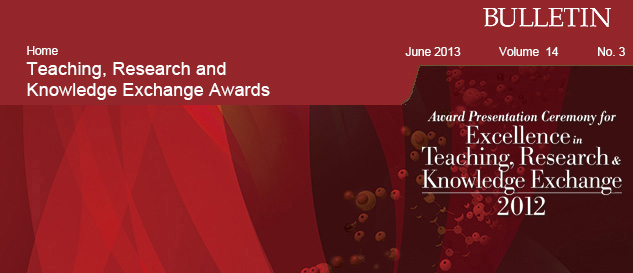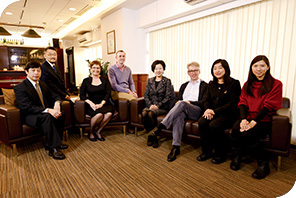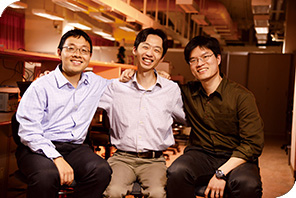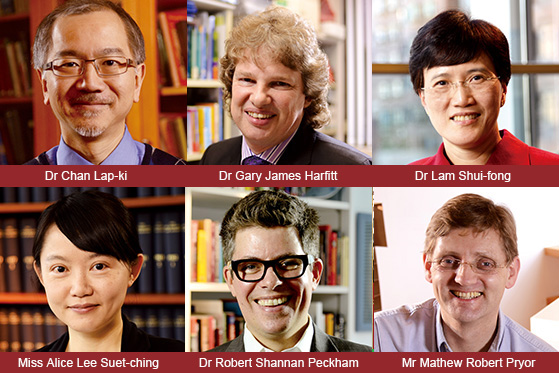| This award signifies the University’s commitment to recognising and promoting excellence in teaching. Both the team and individual awards are given to those who have shown creativity in and dedication to making learning enjoyable and challenging. |
| Outstanding Teaching Award |

|
| Individual Award |
|
|
Dr Chan Lap-ki Institute of Medical and Health Sciences EducationDepartment of Anatomy Anatomy is the foundation of clinical medicine, yet as a subject of study, it can seem dry and technical. Dr Chan’s mission has been to get his students excited and energised about this most meaningful subject. His teaching seeks to help students understand the place of humans in nature, and he encourages them to think rather than answer questions because they will learn more by exploring with their minds. One task he set students was to interview future body donors. Victor Hui, a current MBBS student, said: “This first-hand experience with life and death allowed us to reflect on the nature of life and to prepare our minds before we have to face life and death again in our future career.” That is an outcome that Dr Chan hopes for. “As a surgeon, I can change the structure of the human body. But as a teacher, I can change the minds of my students, a task that I see as much more difficult, but much more fulfilling.” |
|
Dr Gary James Harfitt Faculty of EducationDr Harfitt has been teaching at HKU for 10 years and continues to receive the highest praise from students even years after they graduated. One of the secrets of Dr Harfitt’s success is that he deeply cherishes being a teacher, which is the crux of all the work he does, from research to classroom work to working with local schools. He is also enthusiastic about getting student-teachers to use stories when teaching reading. “If their student doesn’t like reading, maybe we have to go back a little bit rather than push forward with a heavy novel. We need to find texts that are creative and stimulating and colourful, and start from there,” he said. Teaching his student-teachers to focus on their students dovetails with Dr Harfitt’s own feelings about his profession. “The more I teach the more I realise that the key to effective teaching is recognising the students’ needs above my own. Good teaching comes from the heart.” |
|
Dr Lam Shui-fong Department of PsychologyDr Lam still inspires her students with the same passion that she had 18 years ago, when she started teaching at HKU. “My passion for teaching has not faded at all. I understand every student will have a natural motivation for learning if they find meaning in it,” she said. Learning motivation is also her research interest and she uses what she learns to help improve her students’ learning experience. For example, she had them reply to a government consultation on education reform so they would see that their written work could have value beyond being graded by their teacher. “I encourage students to apply their learning in the real world, particularly for the betterment of their community,” she said. But Dr Lam also wants her students to enjoy learning. “The biggest momentum for me is their smiles – I can see they really like learning and they are learning something. That makes me happy.” |
|
Miss Alice Lee Suet-ching Department of LawMiss Lee believes that teaching and learning are two sides of the same coin and that students need to be actively engaged in a subject if they are going to remember it effectively. Her two subjects are Land Law and Intellectual Property Law and she revels in finding real examples in everyday life to explain complicated principles and to spark her students’ imaginations. Miss Lee also believes that building mutual respect and trust is important and takes an interactive approach by having informal chats with students outside of lesson time to find out what really makes them tick. When supervising research students, knowing them well as individuals also aids in identifying a research path that is most suitable for them. “I am concerned about the students’ whole-person development… and I find it rewarding and encouraging when former students of mine share with me their passion for the subject – ‘A life-long interest,’ as one of them put it.” |
|
Dr Robert Shannan Peckham School of Humanities (History)Dr Peckham’s pioneering approach to teaching encourages his students to question received ideas, to think creatively about issues, and, above all, to keep asking questions. As a historian of science and medicines in the School of Humanities he is rethinking the concept of interdisciplinarity and using it as a way to encourage mental agility. “I believe it is crucial for arts students to engage with the issues raised by science, technology and biomedicine,” he said. “Reciprocally, students from science and medicine can benefit greatly from reflection on the social and cultural dimensions of their own practices.” This crossdisciplinary approach is at the heart of the Centre for the Humanities and Medicine, a joint initiative that Dr Peckham has been heavily involved in since its founding in 2009. Said Dr Peckham: “The Humanities nurture vital critical capacities and nurture new ways of thinking about the world, which is a pre-condition for solving problems.” |
|
Mr Mathew Robert Pryor Department of ArchitectureEight years of teaching have taught Mr Pryor many things, one of the most important lessons being the realisation that he achieved far greater success by teaching through practice – that is taking students outside standard classroom and lecture settings and into practical contexts and real-life scenarios. Mr Pryor said, “Get [students] to work on projects that involve their own environment, their own life. Base it in their own district so they can actually see that the projects they do and the information they learn has immediate relevance to them.” More than straightforward experiential learning, Mr Pryor takes his students to everyday physical environments “where the landscape itself becomes a teaching tool, enabling them to experience the practice of landscape architecture and to interact directly with practitioners.” |
| Team Award |
 |
|
From left: Professor Edward Lo Chin-man,
Dr Peter Tsang Chiu-shun, Dr Susan Margaret Bridges (Leader), Dr Rory Munro Watt, Professor Cynthia Yiu Kar-yung, Dr Michael George Botelho, Dr Yang Yanqi and Miss Jessica Wong Wai Faculty of Dentistry The Faculty of Dentistry has long been a leader in problem-based learning (PBL) at the University. The Faculty takes a student-centred, problem-based approach to dental education and its teachers employ innovative ways to support that goal, including increasing use of new technology in the classroom. Heightened visualisations and technological interactivity engage students and deepen their understanding. For example, in PBL tutorial rooms new interactive whiteboards have been installed on which students can move models around, make notes and diagrams and highlight key points. All of that is shared and accessible to everyone in the session. “We are looking at e-learning and how we can engage our students in a 21st century environment through new materials,” team leader Dr Bridges said. Students said the technology helped to improve their learning. In anatomy, for example, rather than reading definitions of complex medical terms aloud, they now access various definitions and diagrams through the interactive whiteboards. Self-learning has also been enhanced by uploading more materials that students can access from anywhere, so learning continues beyond the classroom. |
 |
|
From left: Dr Edmund Lam Yin-mun, Dr Hayden So Kwok-hay (Leader) and Dr Kenneth Wong Kin-yip Department of Electrical and Electronic Engineering The field of electrical and electronic engineering (EEE) has expanded over the years to cover a wide range of new disciplines including optical systems, distributed computing, biomedical engineering and renewable energy. Opening students’ minds to what EEE is about had become quite a challenge and the traditional approach of simply analysing electrical components and circuits was not only boring them but not showing them how wide and interesting the field has become. “To be an engineer you need to be creative and we wanted to create something fun for the students,” said team leader Dr So, adding that they wanted to enthuse the students and to inspire them to pass on their knowledge to others. Along with major all-round curriculum reforms, the EEE department team paid particular attention to the development of a new first-year introductory course that is open to all engineering students. The team fostered an active learning environment in the laboratory, and assigned students to work with new partners each week on the open-ended Rube Goldberg machine project. The work is challenging and demands close collaboration and good communication. |
| Back | Next |
